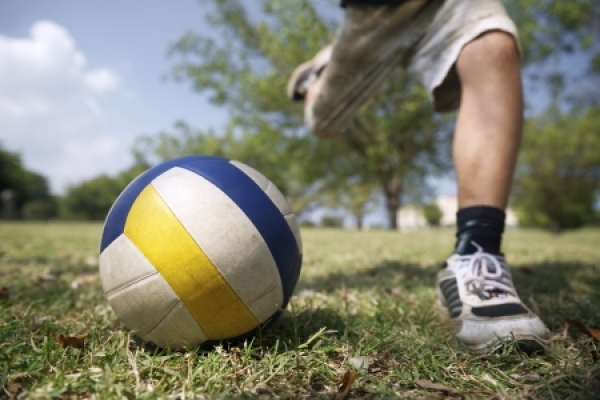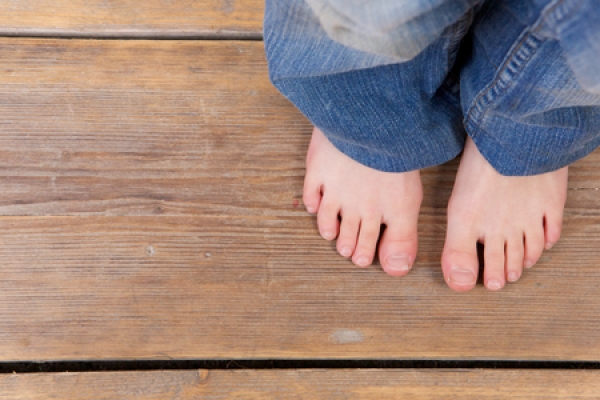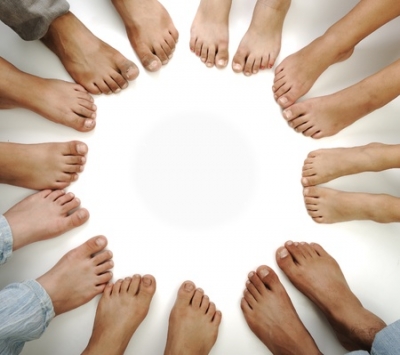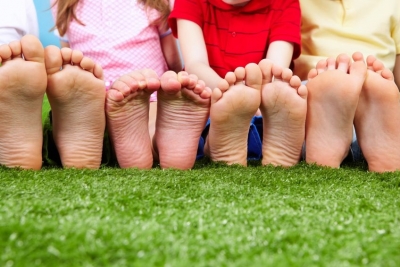Connect With Us
Blogs

Pediatric Foot Conditions (5)
At Superior Foot & Ankle Care Center we treat podiatric problems in Los Angeles County patients of all ages. In July, we recognize Juvenile Arthritis Awareness Month. Nearly 300,000 children and teenagers suffer from Juvenile Arthritis (JA). Some forms are similar to the types of arthritis that adults suffer from, and some are unique to young people.
Many types of JA are autoimmune or autoinflammatory in nature, meaning that the immune system mistakenly attacks healthy tissue with inflammatory chemicals. These can cause joint pain and inflammation, and skin disorders, and internal organ issues. If your child is experiencing joint pain in their feet or ankles, the first step is to make an appointment at our Long Beach office at (562) 420-9800 office so that our podiatrists, Dr. Victoria M. Foley and Dr. Constance Ornelas, can examine your child and determine if the discomfort is strictly podiatric or if arthritis or another disease may be the source. Once a diagnosis is determined, the foot doctor will advise you on treatment or refer you to a specialist in the area of concern. Just as with adults, healthy lifestyle choices can play a key role in managing JA and preventing its progression. Below are three to focus on:
Exercise—Although some types of movement may be painful for children and teens with joint disorders, regular exercise and physical activity is also one of the best weapons in the fight against arthritis. Depending on your child’s age, they may need help finding the activity that best suits their particular type of arthritis. Some good choices include swimming and aquatic classes (the buoyancy of the water naturally reduces pressure on the joints), biking and yoga. Expose your child to several different activities and as they mature, they will gravitate to those that best suit them.
Nutrition—Lower weight means less pressure on joints, especially those in the knees, ankles, and feet. Some foods are also known to decrease inflammation while others spark an inflammatory response. Make healthy eating a family habit and involve your children in choosing nutritious foods and then preparing and eating them together.
Mental Health—Growing up is hard enough without having a chronic disease. Make sure your child has a good support network, spends time with friends, and participates in activities that build confidence. Model positive coping skills for your child and seek professional help if necessary.
At Superior Foot & Ankle Care Center, we treat patients of all ages. Some of our younger patients are not very articulate about foot and ankle pain or discomfort. Children may know that it doesn’t feel good to run but not be able to specifically say that it feels like a rock is pressing into the ball of their foot or that their toenail is sore. That’s when parents have to do a little detective work. See if you notice one or more of these signs that your child may be experiencing a podiatric problem:
- A loss of interest in games and physical activities they normally love. A usually active child who chooses to sit on the sidelines or complains that they feel too tired to play may be masking the fact that his or her feet hurt.
- Your child is always last. Being unable to keep up with their peers in simple outdoor play or more formal sports settings can indicate an improperly functioning foot.
- He’s “running in a funny way.” If you notice your child’s gait has changed, it may be a sign that they are altering the way they move to avoid pain or discomfort. This will often lead to balance issues and an increase in trips and falls.
- Limping or walking on tiptoes. Younger children may be afraid to go to the doctor or not want to take time out from playing, so they keep going, but a change is evident in how they walk and run. That’s when it’s time to examine your child’s feet and see if there are cuts, bruises, swelling, or other potential sources of foot pain. Ingrown toenails, which are particularly common in children, can quickly become swollen and painful but would not be noticeable unless you inspect your child’s feet. Checking children’s feet regularly is a good way to help detect podiatric issues in their earliest stages. If you notice anything unusual, be sure to report it to our podiatrists, Victoria Foley or Dr. Constance Ornelas, so they can diagnose your child’s condition promptly and prescribe the correct treatment. Contact our Long Beach office for an appointment by calling: (562) 420-9800.
At Superior Foot & Ankle Care Center we find that most children’s podiatric issues result either from poor hygiene habits or overuse injuries related to sports activities. One of the difficulties in diagnosing and treating children is that they are not always able to articulate their symptoms or even identify the source of discomfort. Look for these indicators that your child may be experiencing foot or ankle pain:
- Limping or walking or running in an abnormal way.
- Not wanting to participate in sports or other active pursuits that they normally enjoy.
- Complaints of tiredness.
- An increased frequency of trips and falls.
If your child is showing any of these signs inspect their feet completely (but gently—the cause of the pain may be internal). If you notice anything unusual or you don’t see anything but it’s clear that something is wrong with your child’s feet, make an appointment at our Long Beach office so that one of our podiatrists, Dr. Victoria Foley or Dr. Constance Omelas can do a complete podiatric exam.
Practice Safe Sports
You can help prevent injuries and conditions caused by overuse by ensuring that your child has the correct shoes for the sport they are doing and that the shoes fit properly. When children are young it’s likely that they will need a new pair of shoes each season. Have your child’s feet professionally measured and don’t let them wear hand me down sports shoes. Be sure that children warm up and stretch before practices and games and that the conditioning program they are doing allows days of rest between workouts. Heel pain from plantar fasciitis or Sever’s Disease and Achilles tendonitis are some foot conditions that can be caused by too much repetitive activity from a sport or exercise program.
Teach Your Child Healthy Foot Habits
Plantar warts, athlete’s foot, fungal toenails and ingrown nails are also conditions that children commonly experience. These can be avoided if your child follows some simple rules:
- Let mom or dad trim nails appropriately—don’t peel nails or pull them off.
- Wear shower shoes or flip-flops at the town pool and when in gym locker rooms—fungal and bacterial infections are spread by direct contact.
- Don’t share shoes, socks, towels, nail files or any other items that touch someone else’s foot.
If you have questions about your children’s feet, contact us by calling: 562-420-9800.
At Superior Foot & Ankle Center we know the importance for your feet of maintaining a healthy weight. Obesity puts added strain on the muscles, joints and ligaments of your feet and is a risk factor for several foot disorders. September is Childhood Obesity Awareness Month and we want to help families create healthy habits now so that children will grow into healthy adults.
Contributing Factors
Thankfully, the incidence of obese and overweight children appears to have leveled off over the last decade after steadily rising for several decades before. However, we still have a long way to go. Nearly 1/3 of children ages 10-17 are overweight or obese. The lifestyle of the average child has changed dramatically from even 2 or 3 generations ago. Some reasons for the increased weight in young people include:
- Easy access to inexpensive, high calorie foods and sugary drinks
- To much time spent being sedentary and inactive
- Lack of sleep
- Increase in cost of healthy foods
- Decrease in community-oriented opportunities for physical activity
If you consider the number of “screens” most children own, the amount of pre-packaged and process food they consume and the decrease in time and opportunity to simply play outdoors or in the neighborhood, it’s easy to see how the increase in overweight children has occurred.
Ways to Help
There are many options for helping young people attain and maintain a healthy weight, including:
- Get rid of junk food and sugary sodas and snacks. If it’s too much for your family to go “cold turkey,” you can start by swapping in healthier versions of their favorite: frozen yogurt for ice cream, granola bars for cookies, baked chips instead of fried.
- Cook more meals at home. This way you control the ingredients. This is also a great opportunity to get your children involved in learning about healthy meals and helping to plan, shop and cook them.
- Get everyone a water bottle and encourage them to keep it filled. Drinking enough water everyday helps control hunger and will take the place of sweet drinks.
- Make fitness and exercise a priority for the whole family. It doesn’t have to be boring! Ice skating, rollerblading, skiing, hiking, bicycling and team sports are all good and fun choices.
By preventing obesity now when your children are young you will be helping them avoid serious medical conditions down the road which can impact their feet and entire body: diabetes, heart disease, arthritis and more. If you have additional questions about how to be proactive about your child’s foot health, our podiatrists, Dr. Victoria Foley and Dr. Constance Omelas will be happy to answer them. Contact our Long Beach office by calling: 562-420-9800.
Chances are with the end of the school year your child came home with readings lists and other summer work. At Superior Foot & Ankle Care Center we’d like to add one more list: a checklist for taking care of your child’s feet over the summer months. Summer brings a whole new set of activities and options for children, many of which can lead to foot trouble if the proper precautions are not taken. Here are our top tips for keeping children’s feet healthy this season:
Slather on the Sunscreen—many people forget to apply sunscreen to their feet. The skin on your feet is just as susceptible to the harmful effects of UVB and UVA rays as that on the rest of your body. On beach and pool days you should put sunscreen on the tops and bottoms of your children’s feet and reapply after swimming. If your children are wearing sandals or other open shoes and will be out in the sun shopping or sightseeing you should also put sunscreen on their feet then.
Pack the Flip Flops—summertime is high season for athlete’s foot, fungal toenails and warts, all of which are spread by direct contact with the virus, fungi or bacteria that cause them. If you are spending time at a community pool or local beach make sure your child keeps their feet covered around the pool and in changing areas and bathrooms—these are prime hangouts for fungal infections. Encourage your children not to share shoes, socks, towels or any items that touch someone else’s feet.
Inspect Shoes—be sure that your child is wearing shoes that match the activity they are participating in. While flip flops are good for the pool, they can lead to injury if used for playing whiffle ball or other casual summer sports. Also keep an eye on fit—children’s feet grow fast and time spent squeezed into shoes that are too tight can increase the risk of ingrown toenails and fungal infections.
Keep it Clean—wash your children’s feet at the end of every day with a mild soap and warm water. Be sure to dry completely as well, especially between the toes. Trim toenails straight across with no curved edges. If your child’s feet sweat excessively, consider a foot powder to help keep them dry.
If when caring for your child’s feet you notice anything unusual or concerning, or if your child complains of foot pain, don’t hesitate to contact our podiatrists, Dr. Victoria Foley and Dr. Constance Omelas at our Long Beach office by calling 562-420-9800. It’s always better to get a foot concern checked than to wait and have it develop into a serious issue. Enjoy the summer and keep your children’s feet safe!





